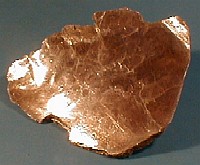

| Lesk je schopnost nerostů odrážet světlo. Je závislý na mnoha činitelích, k nimž patří index světelného lomu, absorpce světla a charakter pozorované plochy (hladkost, drsnost). Lesk nerostu se zvětšuje se zvyšováním světelného lomu, snižuje se s absorpcí světla a s drsností povrchu. Nezávisí na barvě minerálu. |  |
Lustre is the ability of minerals to reflect light from their surface. It depends upon various factors, particularly on the number of rays absorbed or reflected, and on the character of the mineral surface (ie even or rough). The lustre of a mineral increases for these minerals with a high refractive index, and becomes less intense with a higher light absorption, and a rough surface, but it is not dependent on the colour of the mineral. |
| U nerostů rozeznáváme lesk: Kovový - nejvyšší lesk, který je typický pro neprůhledné minerály. Nejlépe je patrný na krystalových nebo štěpných plochách např. galenitu, chalkopyritu, magnetitu. Někdy se hovoří i o polokovovém lesku, který mají průhledné nebo poloprůhledné minerály s indexem světelného lomu 2,6-3,0, např. cinabarit, kuprit. Diamantový - velmi silný lesk průhledných a průsvitných nerostů s indexem světelného lomu 1,92 a více, vyvolaný totálním odrazem světla, např. u cerusitu, zirkonu, diamantu. Skelný - připomíná lesk skla. Je typický pro průhledné a průsvitné nerosty s indexem světelného lomu 1,3-1,9, např. fluorit, křemen, korund. Vedle těchto základních typů rozeznáváme ještě lesk: Mastný - připomíná lesk mastného papíru, což je často způsobeno nerovností povrchu pozorované plochy. Charakteristický je např. pro opál a cordierit. Perleťový - typický je pro nerosty průhledné nebo poloprůhledné, s výbornou štěpností na tenké lupínky nebo destičky, např. sádrovec, stilbit. Hedvábný - význačný je pro nerosty vláknité, např. azbest, krokydolit. Mdlý (matný) - nejnižší stupeň lesku, typický pro minerály zemitého charakteru, např. kaolinit a pyroluzit. Lesk určujeme při denním světle pouze na rovných, nezvětralých a neznečištěných plochách. Stejné minerály nemusí mít vždy stejný lesk. U zrnitých agregátů je lesk méně výrazný než u samostatných krystalů. Např. u magnetitu je na krystalových plochách lesk kovový, v zrnitých masách jen matný. Lesk u zrnitých minerálů lze studovat pod lupou nebo pod mikroskopem. Na štěpných plochách bývá lesk výraznější nežli na plochách krystalových. U tmavých minerálů nelze někdy lesk jednoznačně určit. Zkušený sběratel dovede lesk nerostu stanovit poměrně přesně srovnáním s určitými vybranými vzorky, které si sám odstupňoval. |
The kinds of lustre to be distinguished
are as follows: Metallic lustre (splendent, full) - characteristic of the majority of opaque minerals. It is best seen on freshly fractured surfaces and cleavage planes, eg galena, chalcopyrite or magnetite. Submetallic lustre occurs on transparent or semi-transparent (subtransparent) minerals with a refractive index of 2.6-3.0, such as cinnabar and cuprite. Adamantine lustre (shining) occurs only on transparent and translucent minerals with a refractive index of 1.92 and over, because of the total reflection of light, such as cerussite, zircon and diamond. Vitreous or glassy lustre resembles the lustre of glass. It is typical of transparent as well as translucent minerals with a refractive index of 1.3-1.9, such as fluorite, quartz and corundum. Greasy lustre is a self-explanatory term. This is shown particularly by minerals displaying numerous microscopic inclusions, such as opal and cordierite. Pearly lustre - typical of transparent or semi-transparent minerals with a perfect cleavage, such as gypsum, muscovite or stilbite. Silky lustre - is peculiar to minerals having a parallel, fine-fibrous structure, such as asbestos and crocidolite. Dull (glimmering) lustre - typical of minerals of an earthy character, such as kaolinite and pyrolusite. Lustre is observed in daylight on even, unweathered and clean surfaces. A particular mineral does not always have the same lustre. In granular aggregates the lustre is less evident than in individual crystals. For instance, magnetite has a metallic lustre on its crystal faces but a dull lustre in a granular mass. The lustre of granular minerals can be studied under magnification or by means of a microscope. Cleavage planes have a brighter lustre than crystal faces. It is sometimes very difficult to determine the lustre of dark minerals. However, an experienced collector can specify the type of lustre fairly reliably by comparing other selected types of lustre. |
